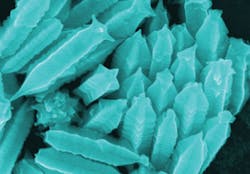NANOTECHNOLOGY/SURFACE-ENHANCED RAMAN SPECTROSCOPY: Extruded-star nanorods boost SERS signals 25X
A new shape of nanoparticle promises to improve medical imaging and chemical sensing applications based on surface-enhanced Raman spectroscopy (SERS). Shaped like extruded stars, the nanorods have proven able to return signals 25 times stronger than similar nanorods with smooth surfaces—and thus to enable detection of trace amounts of DNA and disease biomarkers.1
"There are many cancers where the diagnostics depend on the lowest concentration of the biomarker that can be detected," says Eugene Zubarev, Rice University (Houston, TX) associate professor of chemistry, who worked with graduate student Leonid Vigderman to create the rods. Ongoing experiments with Stephan Link, an assistant professor of chemistry and chemical and biomolecular engineering, will help characterize the rods' ability to transmit a plasmonic signal. "If we can modify the surface roughness such that biological molecules of interest will adsorb selectively on the surface of our rugged nanorods, then we can start looking at very low concentrations of DNA or cancer biomarkers," Zubarev adds.
1. L. Vigderman and E. R. Zubarev, Langmuir, doi:10.1021/la300218z (2012).
More BioOptics World Current Issue Articles
More BioOptics World Archives Issue Articles

